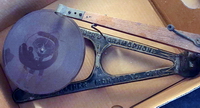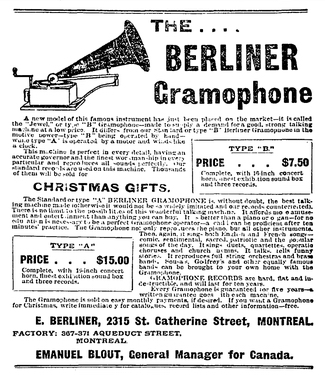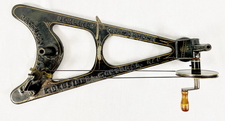|
Rare Canadian Berliner Discovered
by Mark Caruana-Dingli
The completed Berliner Nursery Gram-O-Phone.
The domed front of the Turret reproducer is easily recognized. As on the original, the horn assembly is the same
as that used on the Model "A" (Trade Mark) gramophone. The unusual cast-iron base rests on red felt pads.

|
|
Research contributions by Allen Koenigsberg and Wayne Kosovic
This past year has been exceptional for those of us
who are interested in Berliner gramophones. A number
of rare, sometimes unknown models of gramophones
have been discovered so frequently that just about
every issue of the APN
this year has had one
highlighted in it.
The incomplete gramophone
as found

|
|
This time, the gramophone that has been
discovered is a long-
rumoured Canadian
model that up until now
has been considered
something lost to time.
The model in question
appeared in a full page
ad in La Patrie, Dec 21,
1901. Advertised as
"Le Gram-o-phone des
Enfants" (the children’s
gramophone), this
fabled toy was
a stripped-down hand-
driven version, with a
cast-iron base without any
wooden cabinet or
platform. The poorly
rendered drawing in the
ad does not give much
in the way of detail but
this gramophone was
quite recognizable
because of the unusual cast-iron V - shaped base.
I first heard of this
machine’s unexpected
appearance when I
received a photo from a
collector asking if I had
ever seen anything like
this before and if I had
any information about it. The collector knew that it was
certainly a Canadian machine because the embossing
on the base contained the words "Montreal Can". I’ll be
honest and say that I was not sure what to make of it
with its truly unique and quite memorable design. I
consulted with another collector who specializes in
Berliner, and he immediately recognized it as the one
shown in an ad reprinted from La Patrie on page 24 in
a book every Canadian collector should own, Roll Back
the Years, History of
Canadian Recorded
Sound and its Legacy:
Genesis to
1930, by Edward B.
Moogk; (National Library
of Canada, 1975), once
I realized what it was, its
significance became
apparent. This was
possibly the rarest
Canadian Berliner
Gramophone ever to
have been found.
Full page ad in the Montreal Daily Star, December 14, 1901
Showing the Nursery Gram-o-phone
Courtesy of Allen Koenigsberg

|
|
Full page ad in La Patrie,
December 21, 1901
Courtesy of Wayne Kosovic

|
|
The serial number of
this instrument, 101,
leads me to think that
there should be at least
100 more of these toy
gramophones around.
Could its exceptional
rarity be due to the
fragility of its cast base
and the fact that many
of these may have
succumbed to the same
fate as other children’s
toys?
Close up of Montreal Daily Star ad, December 14, 1901
Surprisingly, the weight is listed as 20 lbs which seems excessive
given that the gramophone by itself only weighs 2.6 lbs.
Courtesy of Allen Koenigsberg

|
|
Close up of the children's records listed in the Montreal Daily Star ad from December 14, 1901

|
|
List of children’s records from Berliner’s 1901
Record Catalogue

|
|
Further investigation turned up two more
ads that identify this 7-inch-playing disc
machine as the
"Nursery Gram-O-Phone", a December
14, 1901 ad in The
Montreal Daily Star with
English text but laid out
the same as the La Patrie ad, and another Montreal
Daily Star ad from December 21, 1901 that contained
no images.
The ads that led to the identification of this gramophone indicate that this was marketed as a child’s
gramophone and was supplied with 3 children’s
records and 200 needles, all for $4, an excellent price
compared to $15 for the spring-wound Type "A" (Trade Mark) model or $40 for the "Grand"
model shown in the ad. The 3 records
included were probably selected from the
five children’s records shown in the ad on
page 4. A sixth children’s record (#715
"The Wedding Of The Frog And The
Mouse" by Messers Spencer and Childs)
was listed the month prior Nov. 1, 1901,
but absent in the newspaper ad.
Front and Back Cover of Berliner’s
November 1, 1901 Record Catalogue
Note: The child shown on the back cover
is Emile’s daughter, Hannah
Courtesy of Wayne Kosovic

|
|
Berliner ad from the Montreal Daily Star,
December 21, 1901.
Note that the Grand, Ideal and Type A specifically
mention the new Turret Concert Sound Box
Courtesy of Allen Koenigsberg

|
|
A little history, for those unfamiliar with
Emile Berliner and his invention of
the flat-disc record and gramophone.
After much success with this innovation,
which he brought to the American market
in 1894 (as U.S. Gramophone Co.),
Berliner had become disillusioned with
the business, now entangled in protracted legal battles over his valuable patents.
Having had enough, Berliner struck a
deal with Eldridge Johnson, who
had been the manufacturer of the
gramophones that were being sold to the
American public. Johnson was to take
ownership of the patents in exchange for
a 40% share in a new company. Upon
prevailing in the courts, Johnson
launched this new business in Oct. 1901 under the
name, "The Victor Talking Machine Company", which went on to dominate the industry for many years.
Toronto Globe, December 15, 1900
Advertising the Berliner "Jewel" Gramophone
Courtesy of Bill Pratt

|
|
Wanting to keep his hand in the industry, Berliner kept
ownership of his Canadian patents and began business here in 1899 under the name "E. Berliner,
Montreal", opening a retail store at 2315-2316 St.
Catherine Street, Montreal. Although his business
began by assembling machines from parts supplied by
Eldridge Johnson in the US, Berliner quickly began to produce a variety of his own models. It was during this
period of intense activity that this little toy "Nursery
Montreal Daily Star,
December 22, 1900
Courtesy of Allen Koenigsberg

|
|
Gram-O-Phone" was conceived.
During the search for this machine’s origin, two earlier
references to a hand driven gramophone were
unearthed in a pair of Canadian print ads. These
Berliner Christmas promotions describe a new Berliner
"Jewel", or model "B", gramophone that appears to be
the same model that later sold for $4 in 1901.
Published in the Toronto Globe newspaper on December 15, 1900 and the Montreal Daily Star on December 22 of the same year, the ads list the machine and
an accompanying three records at a price of $7.50.
This seems to suggest that the Jewel was met with a cool reception from the public before being marketed
as the Nursery Gram-O-Phone in December 1901 for
just $4.00. However, neither of these earlier ads shows
an image of this
unknown machine, so
we cannot say with
certainty that the
Nursery and the Jewel
models are one and
the same.
Close up of the hand driven pulley

|
|
The cast-iron base of the Nursery Gram-O-Phone

|
|
The collector that
originally contacted me
was brokering its sale
for someone else. It
has been speculated
that the gramophone
may have been passed
down through Emile
Berliner’s nephew
Joseph Sanders (1877-1960). Joseph had
worked with his uncle
Emile Berliner and
would have been
involved in research
and development with
Berliner, as can be
attested to by a 1902
reproducer patent that
was taken out in both
their names. If this was
the case, then it is possible that Joseph obtained the gramophone
through his work with Emile or even through his
mother, Rebecca Sanders (née Berliner, 1855-1921),
but this has not been
confirmed. Luckily,
this rare gramophone
landed in the hands of
Mike Lund, an
American collector
who didn’t hesitate to
step up and acquire
this wonderful piece.
Mike is well known in
the hobby, as he has
one of the most
magnificent collections of talking
machines in the
world. I connected
with Mike and was
thrilled that he was
willing to share photos
and information with
me so that I could
document this
discovery here.
Although a few parts
were missing from the
gramophone when it
came up for sale,
thankfully, the
essential parts were all present. The crank/pulley assembly had to be
replicated but a tone arm, reproducer and horn needed
to complete it were replaced with originals, bringing
this machine back to its original state. The reproducer
shown on the completed gramophone is the "Turret
Concert Sound Box", which was introduced in 1901 to
replace the "closed faced" reproducer that preceded it.
If this toy gramophone had entered production, it is
quite likely that it would have been sold with this new
reproducer, since it appears from the text of the ads
that this was what was being supplied on Canadian
Gram-O-Phones at that time,
This discovery is a wonderful addition to the history of
the early years of the talking-machine industry in
Canada. Let's hope that these discoveries continue,
and more previously unknown gramophones are found.
Special thanks to Allen Koenigsberg and
Wayne Kosovic for their expertise, advice and
research contributions to this article.
|